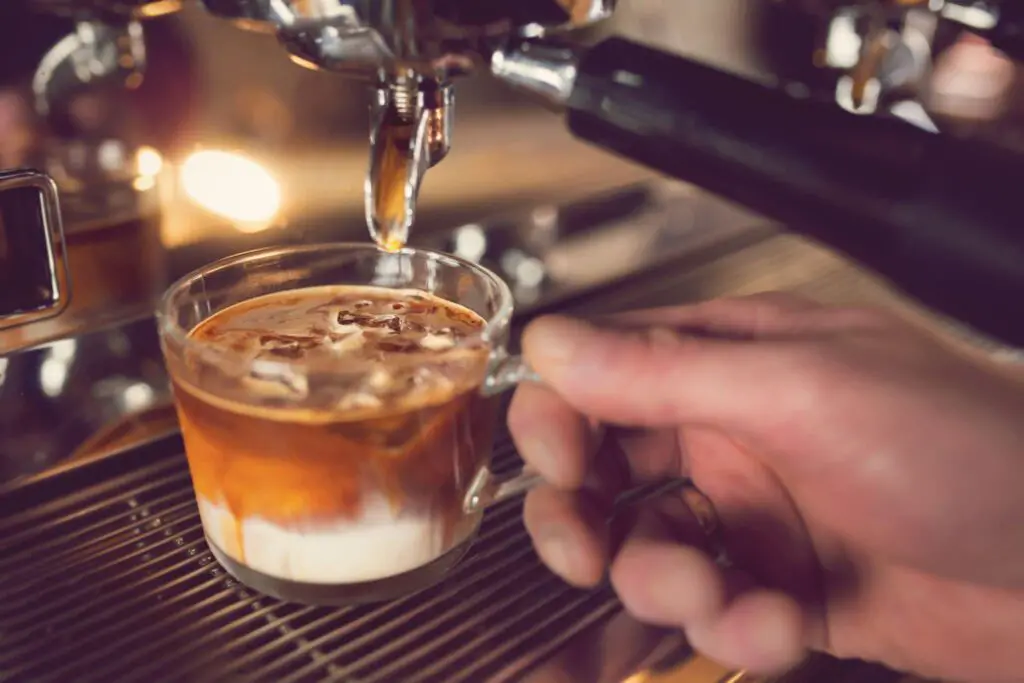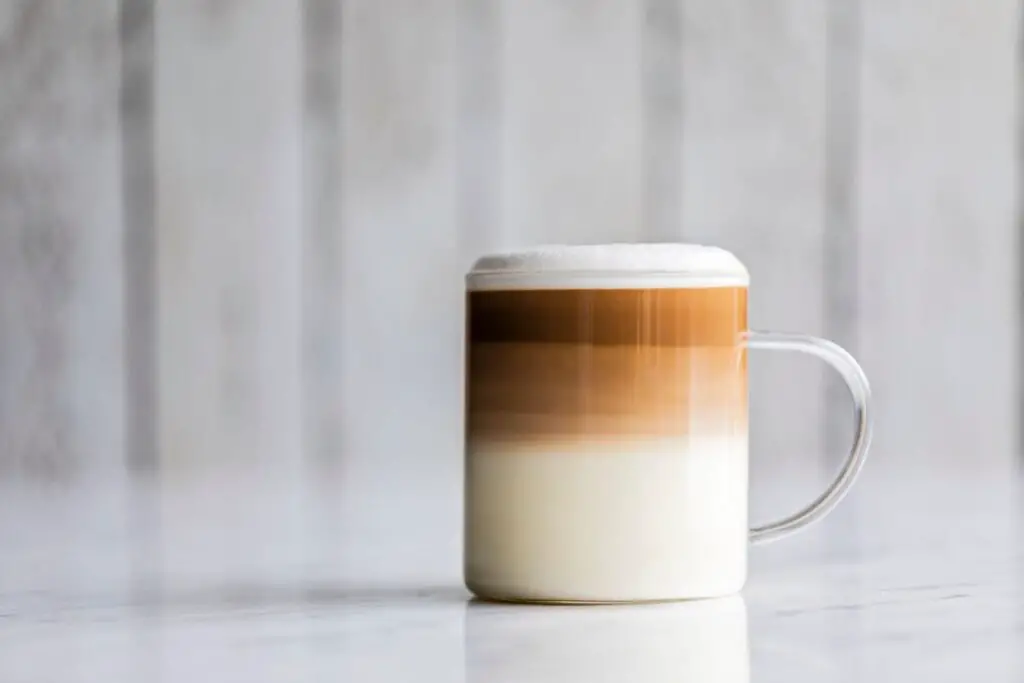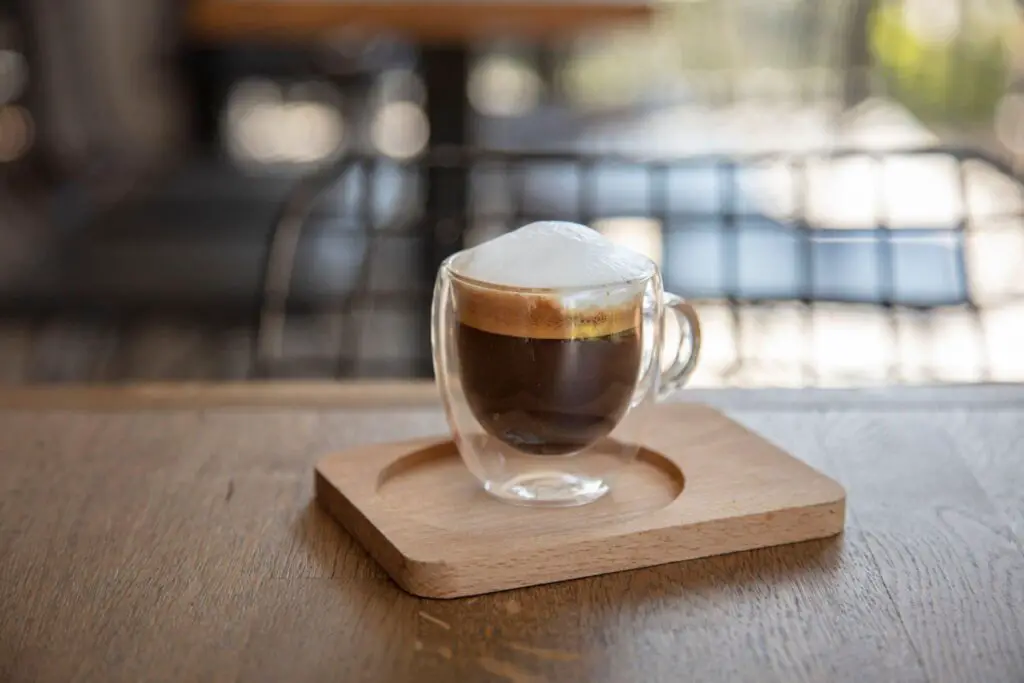Calling all coffee enthusiasts, from beginners to seasoned aficionados, we know you’ll be thrilled to embark on yet another flavorful adventure with us. With so many diverse tastes and tempting concoctions, our fascinating world of coffee never ceases to amaze us. Today, we’re diving deep into the realm of deliciousness surrounding two fan favorites – Macchiato Vs. Latte.
We know your taste buds are already buzzing with excitement, so let’s uncover the similarities, contrasts, and delightful nuances that make each of these cherished classics extraordinary in their own right. Get ready to have your coffee-loving minds enlightened as we embark on the perfect espresso-infused journey to relish the subtleties that make Macchiato and Latte unique yet harmoniously intertwined in the universe of coffee alternatives.
So, buckle up and keep your cups ready and steady as we navigate these two captivating beverages’ swirling creamy mysteries!
Introductory Overview Of Macchiato And Latte Drinks

In the world of coffee, there is a vast array of choices for everyone’s unique taste buds, and two popular options among coffee enthusiasts are Macchiato and Latte. Although they may seem similar at first glance, these milk-based coffee drinks have distinct characteristics that differentiate them. Understanding the similarities and differences between Macchiato and Latte will help you choose the perfect drink to satisfy your caffeine cravings.
Macchiato is a stronger coffee drink made of espresso and steamed milk. In Italian, “macchiato” means “spotted,” which refers to the traditional spot on top of the drink created by pouring espresso directly into a small amount of steamed milk. This caffeine-packed drink is usually served in an espresso cup, holding 2-3 oz of liquid. Small to medium Macchiatos typically contain around 80mg of caffeine, while large ones boast around 120mg.
On the other hand, Lattes, also known as Caffe Lattes, are creamier coffee drinks made up of espresso mixed with larger proportions of steamed milk and topped off with frothed or foamed milk. With a more milk-forward taste, Lattes offers a wide range of flavors and options, such as caramel or oat milk. Small to medium Lattes also contains approximately 80mg of caffeine, while the larger version measures up at around 120mg. However, it’s important to note that Lattes come in much larger sizes compared to Macchiatos, meaning more milk is involved.
In conclusion, the choice between a Macchiato and a Latte mainly boils down to individual taste preferences and desired strength of coffee flavor.
Main Difference Between Macchiato Vs. Latte
The main difference between a Macchiato and a Latte lies in the proportion of milk to espresso and the resulting strength and taste of these popular coffee drinks. A Macchiato, deriving its name from the Italian word for “stained” or “spotted,” is an espresso-based beverage with just a dash of milk added to retain the strong, punchy flavors of the coffee. Typically, a Macchiato consists of approximately 90% coffee and 10% milk, making it a bolder and more intense option compared to a Latte.
On the other hand, a Latte, short for Caffè Latte, which translates to “milk coffee” in Italian, is a creamy and indulgent coffee drink made with approximately 15% coffee and 85% milk. This blend of steamed milk and espresso is topped with a layer of milk foam, providing a smoother and sweeter taste profile perfect for those who prefer a milder coffee experience.
The key difference between a Macchiato and a Latte can be attributed to the amount of milk present in each drink. While a Macchiato offers a stronger and more aromatic flavor due to its higher coffee content, a Latte provides a creamier and sweeter coffee taste owing to its higher milk content. Both options cater to different preferences and showcase the versatility of espresso and milk-based beverages.
5 Different Names For Latte In Various Countries
1. Caffe Latte (Italy) – Originating from Italy, Caffe Latte means “milk coffee” in Italian. It consists of espresso topped with steamed milk and is usually served with a frothy milk foam on top. The creamy texture and rich flavor of a Caffe Latte appeal to many people, and it is often enjoyed with various flavorings like caramel, vanilla, and chocolate.
2. Café au Lait (France) – In France, Café au Lait is a popular milky coffee drink. Similar to a Caffe Latte, it is made with coffee and steamed milk. However, the main difference lies in the type of coffee used, as Café au Lait typically involves strong brewed coffee instead of espresso.
3. Flat White (Australia/New Zealand) – Flat White, originating from Australia and New Zealand, is another variation of the Latte. It is made with a smaller amount of steamed milk, resulting in a smoother, creamier texture. The Flat White typically has a higher concentration of espresso than a traditional Latte and is served with a thin layer of foam instead of a thick, frothy layer.
4. Latté (United States) – The American version of the Latte is inspired by the Italian Caffe Latte but often features flavored syrups and milk alternatives like soy, almond, and oat milk. Flavors commonly found in the United States include vanilla, chai, chocolate, and caramel.
5. Café con Leche (Spain) – In Spain, Café con Leche, meaning “coffee with milk,” is a popular coffee beverage. It consists of equal parts strong brewed coffee and steamed milk, providing a perfect balance of bold coffee and creamy milk flavors. Similar to a Caffe Latte, it can also be made with espresso and enjoyed with various flavorings for a delightful twist.
Traditional Vs. Current Macchiato Variations: Delightful Differences To Savor
Over the years, the classic Macchiato has seen various adaptations, creating a delicious range of flavors for coffee aficionados to enjoy. The traditional Macchiato, a popular Italian coffee blend, consists of rich espresso topped with a small dollop of steamed milk or milk foam, resulting in a bold and intense flavor profile due to the 1:2 milk-to-espresso ratio. Its name, derived from the Italian word meaning “stained,” refers to the eye-catching appearance of the espresso marked with a dash of milk.
In contemporary times, the Macchiato has evolved into an array of delightful variations, which are typically more milk-forward and sweeter than their traditional counterpart. One popular example is the caramel macchiato, featuring the same espresso base but with additional layers of caramel sauce and a higher milk content that softens the intensity of the coffee flavor. Another example is the latte macchiato, where steamed milk is poured first, followed by a shot of espresso, resulting in a 2:1 milk-to-espresso ratio, creating a subtler, creamier taste.
While both the traditional and modern macchiato variations cater to different preferences, they all have one thing in common—each delivers a uniquely enjoyable coffee experience that is sure to delight the palates of coffee lovers worldwide.
Macchiato Vs. Latte: 7 Key Calorie And Health Considerations
When choosing between a macchiato and a latte, it’s essential to consider their calorie content and health factors. Here are seven comparisons to help you make a better-informed decision:
1. Smaller serving size: Macchiatos generally have a smaller serving size of 2-3 ounces, while lattes are larger, typically ranging from 8-16 ounces. Smaller servings usually mean fewer calories.
2. Milk-to-espresso ratio: Macchiatos have a higher espresso-to-milk ratio than lattes, making them more potent and calorie-light, as milk is typically the primary calorie source in these drinks.
3. Latte calories: A 1-ounce serving of a latte contains about eight calories, 0.34 grams of fat, and 0.55 grams of protein.
4. Macchiato calories: A 1-ounce serving of a macchiato holds around five calories, 0.28 grams of fat, and 0.26 grams of protein.
5. Milk options: The type of milk used can significantly affect the calorie count. Whole milk has more fat and calories than skim milk or almond milk.
6. Customizations: Flavored syrups, whipped cream, or sugar added to either drink will increase the calorie count. Opting for sugar-free alternatives or removing these additions can help lower calorie intake.
7. Healthier choice: While neither macchiatos nor lattes are innately unhealthy, the Macchiato’s smaller size, lesser milk content, and fewer calories make it a better choice for those looking to limit calorie intake. Plus, both drinks can be tailored to include healthier options, like alternative milk choices.
In conclusion, understanding these similarities and differences can help you make more informed decisions when craving your favorite espresso-based treat while considering your health and caloric intake.
Read more:
- Mastering The Art Of Making A Perfect Cappuccino Vs. Coffee
- Iced Coffee vs. Iced Latte: Flavor and Textural Differences
- Macchiato Vs Latte: Understanding the Similarities and Differences
- The Key Differences Between Cafe Au Lait and Latte
- What’s the Difference Between an Americano and Cappuccino?
Comparison Of Milk Foam Thickness In Latte Vs. Flat White
Milk foam thickness plays a significant role in distinguishing between a latte and a flat white, as it contributes to the overall texture and taste experience of these popular espresso-based drinks. In this comparison, we’ll delve into the variations in milk foam thickness and their impact on the enjoyment of these two beverages.
First, let’s consider the Latte. Known for its creamy and smooth texture, a latte typically consists of one part espresso, two parts steamed milk, and one part milk foam. This milk foam layer, usually around 1 cm thick, adds a velvety feel to the drink and contributes to its milder coffee flavor. Baristas often create various latte art designs using the frothy milk foam, making the presentation of a latte visually appealing.
On the other hand, flat whites boast a micro-foamed milk consistency that sets them apart from lattes. Microfoam is created by steaming the milk to form a uniform, silky texture, with tiny air bubbles distributed evenly throughout the milk. This results in a thinner layer of milk foam compared to a latte, usually measuring around 0.5 cm thick. Consequently, the flat white delivers a more harmonious blend of coffee and milk, with a richer flavor profile and a smoother mouthfeel.
In conclusion, although latte and flat white both feature milk foam, the thickness and textures differ, influencing these two espresso-based drinks’ overall taste and experience. The Latte presents a creamier and milder drink with thicker milk foam, while the flat white showcases a smoother, more balanced coffee experience with a thinner layer of microfoam.
Components Of Latte And Variations In Taste

When it comes to coffee drinks, the choice between a macchiato and a latte can be confusing for many. Both beverages use espresso and milk as their base ingredients but have unique compositions, taste profiles, and serving methods. In this listicle, let’s dive deeper into the components of a latte and explore its variations in taste.
1. Espresso: The foundation of a latte is its espresso. Typically, a latte comprises one or two shots of espresso. This concentrated liquid provides a deep coffee flavor that balances with steamed milk.
2. Steamed Milk: A major component of a latte is steamed milk, which usually has a ratio of 3:1 with espresso. This creamy, frothy milk gives the Latte its smooth texture and mellow coffee flavor.
3. Milk Foam: The topping layer of a latte consists of a small dollop of milk foam, adding the perfect finishing touch. This foam adds an appealing aesthetic and imparts the drink with a rich, velvety texture.
4. Flavor Variations: Lattes provide a versatile canvas for experimenting with different flavor combinations. Popular options include caramel, chocolate, and vanilla, which blend seamlessly with creamy milk and robust espresso. These flavored lattes offer a delightful twist on the classic version and can suit various taste preferences.
In conclusion, knowing the components of a latte and its flavor variations can help you choose the most suitable coffee beverage for your palate. While the Macchiato offers a stronger coffee flavor with less milk, a latte provides a smoother, creamier experience with a range of flavor possibilities. Happy sipping!
6 Flavoring Options In A Latte For A Delightful Twist
1. Caramel Latte: A sweet and rich option, caramel syrup is added to a latte to create a caramel latte. This popular choice is creamy and indulgent, perfect for those with a sweet tooth. The combination of espresso, steamed milk, and caramel syrup creates a well-rounded and balanced coffee drink.
2. Vanilla Latte: Another fan favorite, the vanilla latte combines the smooth flavor of vanilla syrup with the classic Latte. The subtle sweetness of vanilla complements the espresso and milk, resulting in a delightful coffee experience.
3. Hazelnut Latte: Try a hazelnut latte for a slightly nutty twist. The addition of hazelnut syrup to a latte adds a unique and delicious flavor. The combination of the nutty taste with the creaminess of steamed milk makes this Latte variation a great choice for when you’re craving something slightly different.
4. Mocha Latte: Coffee and chocolate lovers, rejoice! The mocha latte combines espresso, steamed milk, and chocolate syrup for an irresistible coffee treat. Often topped with whipped cream, this indulgent Latte is perfect for those days when you want to spoil yourself.
5. Pumpkin Spice Latte: A seasonal favorite, the pumpkin spice latte is made by adding pumpkin spice syrup (a blend of cinnamon, nutmeg, and cloves) to your classic Latte. This warm, comforting flavor is perfect for sipping on a crisp autumn day.
6. Peppermint Latte: Another seasonal delight, a peppermint latte is created by adding peppermint syrup to your standard Latte. This cool, refreshing flavor is perfect for the winter holidays, providing a festive boost to your daily coffee routine.
In conclusion, adding delicious flavored syrups to your classic Latte can create a delightful twist to your daily caffeine fix. From sweet caramel to refreshing peppermint, there’s a flavored latte option for everyone’s taste preference.
Caffeine Content In Latte And Double Shot Variation
When it comes to coffee, caffeine content plays a crucial role in determining the strength, flavor, and impact of the beverage on the one consuming it. In this regard, understanding the caffeine content in a latte and its double shot variation becomes important, as it allows coffee lovers to make informed choices based on their preferences and personal caffeine tolerance.
A latte is a popular coffee drink that combines espresso with steamed milk and a layer of microfoam on top, resulting in a delicious beverage that balances the bold taste of espresso with the creamy sweetness of the milk. A single (small) latte typically contains around 63 mg of caffeine due to the caffeine being solely present in the espresso shot. The milk in the Latte does not contain any caffeine; thus, the overall caffeine content depends on the amount of espresso used.
However, when opting for a double shot latte (large), the caffeine content increases, as two espresso shots are used instead of one; consequently, a double (large) latte may have around 125 mg of caffeine, providing extra energy for those requiring it. In summary, the caffeine content in a latte and its double shot variation is a significant aspect to consider for individuals seeking the right balance between flavor and stimulation in their coffee experience.
Preparing Macchiato And Latte At Home: A Step-by-step Guide
To prepare delicious Macchiatos and Lattes at home, follow these easy steps for each coffee variant.
Macchiato:
1. Prepare a shot of espresso using an espresso machine or stovetop espresso maker. Aim for a yield of about 1-1.5 oz (30-45 ml) of espresso.
2. Steam a small amount of milk (about 1-2 oz or 30-60 ml) until it reaches a temperature of around 150°F (65°C). Microfoam should form during the steaming process.
3. Pour the espresso into a small, 2-3 oz (60-90 ml) espresso cup.
4. Carefully spoon a dollop of milk foam on top of the espresso, creating the “spot” or “stain” characteristic of a Macchiato.
Latte:
1. Prepare a shot of espresso as mentioned above.
2. Steam a larger amount of milk (about 5-6 oz or 150-180 ml) until it reaches a temperature of around 150°F (65°C). Ensure that you create a creamy microfoam texture.
3. Pour the espresso into a larger, 8-10 oz (240-300 ml) cup.
4. Gradually pour the steamed milk over the espresso, holding back the foam with a spoon. The ratio should be around ⅓ espresso to ⅔ steamed milk.
5. Finish by gently spooning the milk foam on top of the Latte. Optionally, you can create latte art or add flavored syrups to taste.
There you have it! Enjoy your homemade Macchiato or Latte, and feel free to experiment with different coffee beans, milk alternatives, and additional flavors to create your perfect cup.
FAQ: Understanding The Similarities And Differences Between Macchiato And Latte

Q: What are the main similarities between a Macchiato and a Latte?
A: Both Macchiato and Latte are espresso-based coffee drinks, containing espresso and milk as their base ingredients. They also have different variants available at most coffee shops.
Q: Which coffee drink is stronger, a Macchiato or a Latte?
A: A Macchiato is stronger than a Latte due to the higher proportion of espresso relative to milk. Macchiato has a bold and intense espresso flavor, while Latte is milder because it contains more steamed milk.
Q: Which coffee drink is sweeter, a Macchiato or a Latte?
A: A Latte is generally sweeter than a Macchiato because it has more steamed milk and milk foam, which adds a natural sweetness. However, modern Macchiatos may also be sweetened with added flavors like caramel.
Q: Which coffee drink has more caffeine, a Macchiato or a Latte?
A: A Macchiato contains more caffeine than a Latte. The ratio of espresso to milk in a Macchiato is around 90% espresso to 10% milk, while in a Latte is about 15% coffee and 85% milk. This makes the Macchiato higher in caffeine content compared to the Latte.
Q: How does the size of a Macchiato and a Latte differ?
A: A Macchiato is usually smaller in size, about 2-3oz, and served in a small shot cup, while a Latte can be anywhere from 8oz to 16oz and is served in a tall glass.
Q: What is the difference between traditional and Latte Macchiato?
A: The main difference is the layering and proportion of the ingredients. A Latte Macchiato has more steamed milk than a traditional Macchiato and is layered with steamed milk at the bottom, topped with milk foam, and finished with a double shot of espresso. This results in a bolder flavor than a Latte but less intense than a traditional Macchiato.
Conclusion
In conclusion, the debate of Macchiato vs. Latte comes down to personal preference and taste. Both of these delicious espresso-based beverages have their own unique characteristics that cater to different preferences. If you enjoy a strong and bold coffee experience with a prominent espresso flavor, then a macchiato might be the perfect choice for you. With its higher caffeine content and layer-by-layer tasting experience, the Macchiato is sure to please coffee lovers who prefer their coffee with a punch.
On the other hand, if you’re more inclined towards a smooth, creamy, and less intense coffee experience, then a latte could be your go-to drink. With its higher milk content, sweeter taste, and blended flavors, the Latte will satisfy those looking for a comforting and delicious beverage that doesn’t overpower the palate. Additionally, the Latte offers more versatile options when it comes to customizations, such as flavored syrups and alternative milk choices.
While Macchiato and Latte have distinct differences, they also share similarities, such as their espresso and milk base ingredients. Ultimately, it’s essential to experiment and try these beverages for yourself to determine which suits your tastes. Whichever you choose, you’re bound to enjoy a delightful and satisfying coffee experience reflecting the rich and diverse world of espresso beverages.

James Robinson loves coffee and blogging all about coffee. His blog is full of informative posts about the best ways to enjoy coffee and the many different types of coffee out there. He also shares recipes for delicious coffee-based dishes, and his followers can always count on him to offer tips on how to improve their coffee-making skills.
